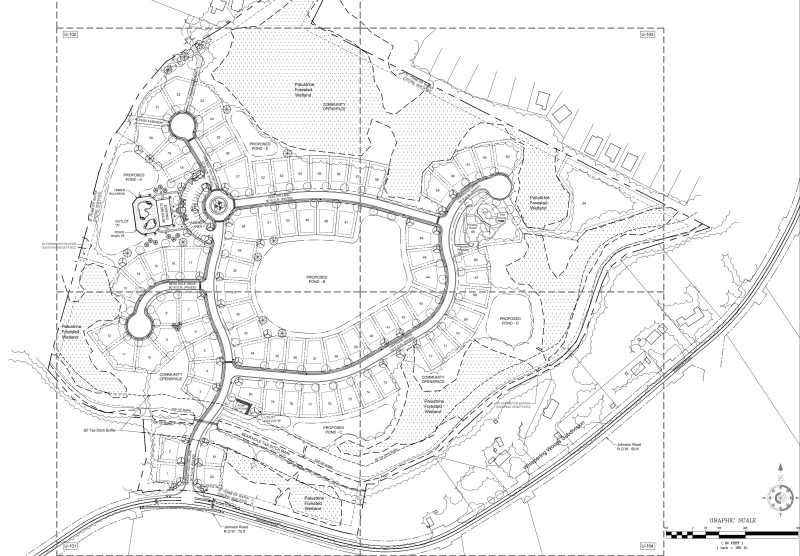A Superior Court judge has thrown out two conditions of approval placed on a Selbyville-area cluster subdivision’s preliminary approval by Sussex County planners.
In a decision released Oct. 1 that could guide county officials in the future, Judge Craig A. Karsnitz said Sussex County Planning & Zoning Commission overstepped when it forced the developer of the Smokey Hollow development to remove a lot from its site plan and abide by a fixed buffer from all nontidal wetlands.
“American legal and political thought has always valued giving landowners freedom to use their property as they see fit,” Karsnitz wrote in his introduction. “As congestion increases, zoning regulations have limited landowners’ freedom. A compelling limitation on land-use regulation requires clear and specific designation of what is allowed and what is prohibited. This clear and specific rule allows fairness to landowners so that they know their rights in advance of purchase or development.”
Sussex County argued that even if a proposed subdivision meets all requirements, it may still limit the development by applying a number of general goals. One example cited by the county in its arguments is to limit the effect of a development on local school districts.
“At oral argument on the petition, in response to a hypothetical question as to whether it could limit to 40 lots a development which the code permitted 60 lots, in order to ameliorate any effect on schools, [the county] answered yes,” Karsnitz wrote.
Karsnitz suggests the county did not apply the law as intended.
“Accepting [the county’s] position would provide it limitless discretion and power to shape land developments well beyond the written Sussex County Code,” Karsnitz writes. “It would also fly in the face of the requirement that landowners be put on written notice in advance of what is allowed.”
Smokey Hollow was proposed as an 82-lot cluster subdivision on 66 acres. After the developer submitted its initial application in October 2022, the county’s planning & zoning commission approved the preliminary plan in April 2024, but it attached 19 conditions, including a fixed 25-foot minimum buffer for tidal wetlands and the removal of a single lot. The developer asked the commission to reconsider the conditions, but they were upheld in August 2024.
In its lawsuit against the county, the developer argues the commission had no standing to force removal of a lot that complies with code.
In its letter to the commission seeking removal of the conditions, the developer warns the county it has no right to deny the conforming lot.
“Under the original plan, Lot 64 is one of the most desirous (and valuable) lots in the community,” the letter states. “For our purposes here, though, all that matters is that it conforms to all code requirements.”
The developer argues the only reason the lot was removed by the commission is because residents in a neighboring community said the lot was too close to their properties.
As for the buffer, the developer argues no requirements were in place when the application was submitted; therefore, the plan does not have to follow requirements added after the fact. Those requirements, passed in November 2022, say a project must have an average buffer of 30 feet from nontidal wetlands, not a fixed buffer as the planning & zoning commission’s condition states. If a fixed buffer was applied to the plan, the developer argues it would lose eight additional lots.
The final line in the county’s ordinance establishing the new buffer regulations states the ordinance shall not apply to any completed applications on file with the Sussex County Office of Planning & Zoning.
In its letter to the commission seeking removal of the condition, the developer offered to follow the 30-foot average buffer for the neighborhood, which would not result in the loss of lots and would increase overall buffering. It described the compromise as a win-win.
“In the absence of this relief, there will be significant financial loss for the applicant, and the need for a substantial (indeed, nearly total) redesign of the project,” the developer states in its letter.
The commission did not agree to the compromise and upheld its original conditions for approval, resulting in the developer taking legal action against the county.
If the county chooses to appeal the Superior Court decision, the next stop would be Delaware Supreme Court.
Nick Roth is the news editor. He has been with the Cape Gazette since 2012, previously covering town beats in Milton and Lewes. In addition to serving on the editorial board and handling page layout, Nick is responsible for the weekly Delaware History in Photographs feature and enjoys writing stories about the Cape Region’s history. Prior to the Cape Gazette, Nick worked for the Delmarva Media Group, including the Delaware Wave, Delaware Coast Press and Salisbury Daily Times. He also contributed to The News Journal. Originally from Boyertown, Pa., Nick attended Shippensburg University in central Pennsylvania, graduating in 2007 with a bachelor’s degree in journalism. He’s won several MDDC awards during his career for both writing and photography. In his free time, he enjoys golfing, going to the beach with his family and cheering for Philadelphia sports teams.























































